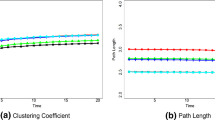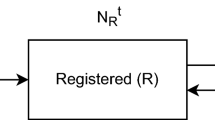Abstract
How does a social network evolve? Sociologists have studied this question for many years. According to some famous sociologists, social links are driven by social intersections. Actors who affiliate with the shared intersections tend to become interpersonally linked and form a cluster. In the social network, an actor cluster could be a clique or a group of several smaller-sized cliques. Thus we can conclude that a social network is composed of superposed cliques of different sizes. However, sociologists did not verify the theory in large scale data due to lack of computing ability. Motivated by this challenge, incorporated with the theory, we utilize data mining technologies to study the evolution patterns of large scale social networks in real world. Then, we propose a novel Clique-superposition generative model, which generates undirected weighted networks. By extensive experiments, we demonstrate that our model can generate networks with static and time evolving patterns observed not only in earlier literature but also in our work.
Similar content being viewed by others
References
Wasserman S, Faust K. Social Network Analysis: Methods and Applications (Structural Analysis in the Social Sciences). Cambridge: Cambridge University Press, 1994
Feld S L. The focused organization of social ties. Am J Sociol, 1981, 86: 1015–1035
Faloutsos M, Faloutsos P, Faloutsos C. On power-law relationships of the internet topology. In: Proceedings of ACM SIGCOMM’99. New York: ACM, 1999. 251–262
Kumar R, Raghavan P, Rajagopala, S, et al. Trawling the web for emerging cyber-communities. Comput Netw, 1999, 31: 1481–1493
Adamic L A, Buyukkokten O, Adar E. A social network caught in the web. First Monday, 2003, 8
Yan F, Zhang M, Sun T, et al. Analyzing user’s book-loan behaviors in peking university library from social network perspective. In: Proceedings of ACM JCDL’09. New York: ACM, 2009. 461–462
Nanavati A, Singh R, Chakraborty D, et al. Analyzing the structure and evolution of massive telecom graphs. IEEE Trans Knowl Data En, 2008, 20: 703–718
Clauset A, Shalizi C R, Newman M E J. Power-law distributions in empirical data. SIAM Rev, 2009, 51: 661–703
Barabasi A L, Albert R. Emergence of scaling in random networks. Science, 1999, 286: 509–512
Newman M E J. The structure of scientific collaboration networks. P Natl Acad Sci, 2002, 99: 7821–7826
Erdos P, Renyi A. On the evolution of random graphs. Publ Math Inst Hung Acad Sci, 1960, 5: 17–61
Dorogovtsev S N, Mendes J F, Samukhin A N. Structure of growing networks with preferential linking. Phys Rev Lett, 2000, 85: 4633–4636
Kleinberg J, Kumar R, Raghavan P, et al. The web as a graph: measurements, models, and methods. In: Proceedings of COCOON’99. Belin: Springer, 1999. 1–17
Kumar R, Raghavan P, Rajagopalan S, et al. Extracting large-scale knowledge bases from the web. In: Proceedings of VLDB’99. New York: ACM, 1999. 639–650
Bianconi G, Barabasi A L. Competition and multiscaling in evolving networks. Europhys Lett, 2001, 54: 436–442
Chakrabarti D, Faloutsos C. Graph mining: laws, generators, and algorithms. ACM Comput Surv, 2006, 38: 1–78
Leskovec J, Kleinberg J, Faloutsos C. Graphs over time: densification laws, shrinkingdiameters and possible explanations. In: Proceedings of KDD’05. New York: ACM, 2005. 177–187
Leskovec J, Backstrom L, Kumar R, et al. Microscopic evolution of social networks. In: Proceedings of KDD’08. New York: ACM, 2008. 462–470
Zheleva E, Sharara H, Getoor L. Co-evolution of social and affiliation networks. In: Proceedings of KDD’09. New York: ACM, 2009. 1007–1016
McGlohon M, Akoglu L, Faloutsos C. Weighted graphs and disconnected components: patterns and a generator. In: Proceedings of KDD’08. New York: ACM, 2008. 524–532
Du N, Faloutsos C, Wang B, et al. Large human communication networks: patterns and a utility-driven generator. In: Proceedings of KDD’09. New York: ACM, 2009. 269–278
Easley D, Kleinberg J. Networks, Crowds, and Markets: Reasoning about a Highly Connected World. Cambridge: Cambridge University Press, 2010
Guillaume J L, Latapy M. Bipartite graphs as models of complex networks. Physica A, 2006, 371: 795–813
Cai S, Su K, Chen Q. EWLS: a new local search for minimum vertex cover. In: Proceedings of AAAI’10. Menlo Park: AAAI, 2010. 45–50
Heras F, Bañeres D. The Impact of max-sat resolution-based preprocessors on local search solvers. J Satisf Bool Model Comput, 2010, 7: 89–126
Mislove A, Marcon M, Gummadi K, et al. Measurement and analysis of online social networks. In: Proceedings of IMC’07. New York: ACM, 2007. 29–42
Granovetter M. The strength of weak ties. Am J Sociol, 1973, 78: 1360–1380
Author information
Authors and Affiliations
Corresponding author
Rights and permissions
About this article
Cite this article
Yan, F., Cai, S., Zhang, M. et al. A clique-superposition model for social networks. Sci. China Inf. Sci. 56, 1–19 (2013). https://doi.org/10.1007/s11432-011-4526-y
Received:
Accepted:
Published:
Issue Date:
DOI: https://doi.org/10.1007/s11432-011-4526-y




